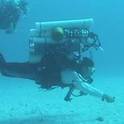
Article
Analytical solution of the nitracline with the evolution of subsurface chlorophyll maximum in stratified water columns
Biogeosciences
Document Type
Article
Rights and Access Note
This Item is protected by copyright and/or related rights. You are free to use this item in any way that is permitted by copyright and related rights legislation that applies to your use. Rights assessment remains the responsibility of the researcher. In addition, no permission is required from the rights-holder(s) for non-commercial uses.
Publication Date
5-10-2017
Abstract/ Summary
In a stratified water column, the nitracline is a layer where the nitrate concentration increases below the nutrient-depleted upper layer, exhibiting a strong vertical gradient in the euphotic zone. The subsurface chlorophyll maximum layer (SCML) forms near the bottom of the euphotic zone, acting as a trap to diminish the upward nutrient supply. Depth and steepness of the nitracline are important measurable parameters related to the vertical transport of nitrate into the euphotic zone. The correlation between the SCML and the nitracline has been widely reported in the literature, but the analytic solution for the relationship between them is not well established. By incorporating a piecewise function for the approximate Gaussian vertical profile of chlorophyll, we derive analytical solutions of a specified nutrient-phytoplankton model. The model is well suited to explain basic dependencies between a nitracline and an SCML. The analytical solution shows that the nitracline depth is deeper than the depth of the SCML, shoaling with an increase in the light attenuation coefficient and with a decrease in surface light intensity. The inverse proportional relationship between the light level at the nitracline depth and the maximum rate of new primary production is derived. Analytic solutions also show that a thinner SCML corresponds to a steeper nitracline. The nitracline steepness is positively related to the light attenuation coefficient but independent of surface light intensity. The derived equations of the nitracline in relation to the SCML provide further insight into the important role of the nitracline in marine pelagic ecosystems.
Citation/Publisher Attribution
Gong,X.,W. Jiang, L. Wang, H. Gao, E. Boss, X. Yao, S. Kao, and J. Shi, 2017 Analytical solution of the nitracline with the evolution of subsurface chlorophyll maximum in stratified water columns. Biogeosciences, 14, 2371–2386, doi:10.5194/bg-14-2371-2017.
Publisher Statement
© 2017 Author(s).
DOI
10.5194/bg-14-2371-2017
Version
publisher's version of the published document
Citation Information
Xiang Gong, Wensheng Jiang, Linhui Wang, Huiwang Gao, et al.. "Analytical solution of the nitracline with the evolution of subsurface chlorophyll maximum in stratified water columns" Biogeosciences Vol. 14 Iss. 9 (2017) p. 2371 - 2386 Available at: http://works.bepress.com/emmanuel_boss/26/
